Make Your own Tire Sandals
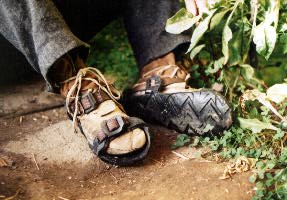
I’m hard on shoes. It’s not uncommon for me to go through half a dozen pairs of shoes, or more, each year. I maintain an active lifestyle, hiking, playing, camping, and working. Water wears out a shoe quicker than anything else. A few trips in and out of the creeks, puddles, and swamps, and they just come unglued.
Participating in Nature book cover. If I do not happen to dissolve my shoes in water, then I wear out the soles on gravel. It has always amazed me that tire companies can manufacture a tire and warranty the tread for some 50,000 miles, yet I can wear out the sole on any ordinary shoe in less than a year. How come we cannot buy a shoe with a 50,000 mile warranty?
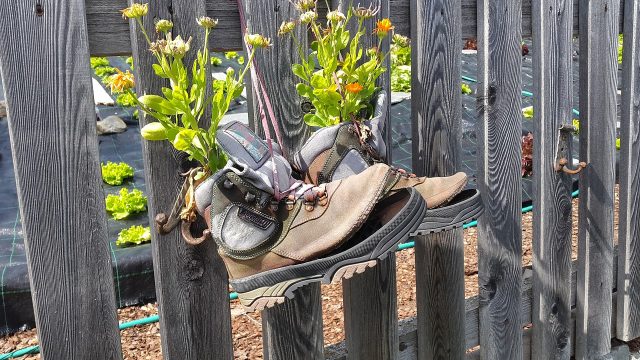
Really, I have never been quite satisfied with conventional shoes, and it’s not just because I wear them out so easily. Mostly it is because I do a lot of camping, and ordinary shoes have a lot of drawbacks for this type of lifestyle. For one thing, I tend to rot my feet out each summer. Shoes are like incubators, holding in the dirt and sweat at warm temperatures, and culturing all kinds of fungus and bacteria. Walking through a little bit of water once or twice a day just compounds the problem, making it nearly impossible to dry out the shoes. My feet even rot when I take care of them, washing and drying my crusty socks each day.
While I am at it, I have other complaints too. You see, I do a lot of primitive camping, building my own shelters, starting fires without matches, gathering wild foods–that sort of thing. To me this type of camping is a way of getting close to nature, by participating in nature, instead of merely camping in it. I like to touch nature, and I feel so removed in a pair of ordinary shoes.
I go barefoot as much as I can, but like most people, I have tender feet–because I don’t go bare foot all the time. Moccasins are ideal for camping, at least to a point. I can really feel the earth through them, and it has a profound psychological on me, making me feel so much more in tune with my surroundings. The trouble with moccasins is they wear out–fast. It takes me about eight hours of physical labor to tan a deer hide, several more hours to stitch a pair of moccasins, and generally one or two days of hiking to wear the first hole in them. The holes always start at the toughest points on your foot, so they are not initially a problem. You can get several more days of hiking in before you have to stitch in a new sole. Still, that is not a very long time at all. I have heard that some Native Americans carried multiple pairs of moccasins on journeys and spent each evening around the campfire fixing them.
I may practice primitive camping, but I also have to face the modern realities of the clock. My camping trips are typically short, and full. I always have a lot of things I want to do while I am out. Fixing my moccasins every day is not one of them.
To solve that problem, I have tried over the years many marriages between buckskin and rubber to make lasting soles on my moccasins. The “paint-on” sole, a mixture of ground up tires and Barge Cement glue, does not work all that well. It helps, but even that wears through quite quickly under harsh conditions, and the rubber coating makes it difficult to dry out the leather of the moccasins. More so, they are not very patchable once a hole gets started.
I have also tried working with the “crepe soles”, a thick sheet of rubber cement that you can buy, cut, and glue to the bottoms of shoes. The problem I had with these is that my foot no longer stayed in the right place on my moccasins. My foot was typically sliding off the back edge of the sole.
After all these life-long problems with shoes, I was ecstatic to learn of something that actually did work. My friend Jack Fee and I were preparing to go out on a three-week expedition in the mountains. He made a new backpack for the trip, and I made some new moccasins. The best idea I had left to try for protecting the soles was a mixture of pine pitch, charcoal, and dried manure. I figured I could easily dope a little fresh material on the soles each night at camp to keep them from wearing out. I thought I was on to something, and the finished sole even looked good. Unfortunately, I wore completely through the pitch in two short city blocks, on a test run. I was out of a plan before we had even begun our expedition.
Jack then told me a story about Indians from Mexico coming to the United States and winning foot races in sandals cut from tires. I’ve been interested in using tire soles before, but it seemed like I would have to glue or stitch the tire to the moccasins. I had reason to doubt that it would work. I also once had a pair of tire sandals, made in Mexico, where the leather lacing was nailed to the tire soles. Those came apart within a couple of days.
Jack had never seen the tire sandals that were reportedly used by the Mexican Indians, but decided to see what he could do anyway. I have to say I was quite impressed with the final product, a sort of Teva-style sandal.
I was most impressed with the fact that there was no glue, and no stitching or strapping on the bottom of the sole where they would be exposed to the ground. Instead he cut the sole with some side tabs out of the tire as one contiguous piece. The first model was a little crude in appearance, but was amazingly comfortable. I too had to make a pair for the expedition.
The field tests of our sandals were quite exciting. The tire sandal and moccasin combination meant we had “modular” shoes. We wore both the moccasins and the soles when hiking, and then just one or the other around camp. We could use just the moccasins for stalking, or just the tires for walking in water. We climbed 10,000-foot peaks twice and generally just put on the miles. I did not wear socks, and never washed my moccasins, but my feet were in healthy condition for the duration of the trip– a first for me.
We did find that we would get blisters if we wore just the tires for any significant hiking, but we seemed to have no problems when the tires were worn in combination with moccasins, or with a couple pairs of heavy socks. I was amazed at how comfortable these sandals were, particularly because I once wore conventional hiking boots on a 500-mile walk across Montana, with severe blistering for the first 250 miles of the trip. Our new type of footwear gave me a freedom and comfort I had been searching for for a decade.
Our prototype sandals were crude, but effective. Since then, I have developed the idea some more, into the tire sandals shown in these pictures. The most significant modification was the addition of the tab at the very back of the sandals. That tab is not normally necessary, except in water. Without it your feet tend to slide forward off the front of the soles when the tires are wet. That back tab holds your foot securely in place. I also added the rubber buckles, and did away with the rope and buckskin ties of our early models.
Also for our prototypes we just traced around a pair of conventional Tevas onto a tire, and started from there. I have since developed a system for creating a pattern to match your own foot. Plan on spending most of an entire day making your first pair. You will get faster as you make more.
Making Your Tire Sandals
First, place either foot in the center of a large piece of paper, at least an 8 1/2 x 14. Trace around your foot, being careful at all times to keep the pencil straight up and down. Next make a mark on each side, directly down from the point on your ankles (A) (see pattern at the end of this web page). Also make a mark at the point along the inside of your foot, directly back from your big toe (B).
Remove your foot from the pattern. Now sketch a bigger outline around the tracing of your foot. Add about 3/8 inch for the toes and sides, but not to the back. Then use a ruler and bisect the pattern lengthwise, extending the line three inches past the heel. This serves as a guide to help you sketch the rear tab accurately. Now connect the marks you made by your ankles (A), extending a line three inches beyond each side of the pattern. These tabs will be sketched in front of this line. Also draw a line for the front tabs, extending from the single mark (B) across the pattern, perpendicular to the line that bisects the foot lengthwise.
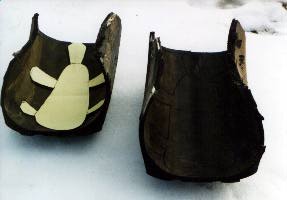
The positioning of all these tabs is quite variable, and you can choose to move them forward or back, or at angles to one another, and all usually work, although the arrangement I have suggested may work more consistently. Problems usually arise with the front set of tabs. When at angles across the pattern they can twist a little and dig into your foot. If the tabs are moved forward or back then the edges can dig into that point (B) on the inside of your foot. That point is more pronounced on some people’s feet than on others.
Now sketch in the five tabs, as shown on the pattern. These tabs are sized width-wise for 3/4 inch wide strapping, and should be made according to the approximate dimensions I’ve written in on the pattern, regardless of how big or small the foot. If anything you might make some adjustments length-wise, adjusting for particularly large or small feet. Finally, sketch in the holes that you will cut out to thread the strapping through. This just helps you remember to cut them the right direction when you get to that stage. Cut the pattern out, and it can be used for both sandals, assuming your feet are fairly similar to one another.
As for tires, I would recommend truck tires, rather than car tires. The “corner” of any tire, where the sidewalls and tread come together, is always much thicker than the rest. You can work with that thickness in the tabs of the sandals, but not in the sole itself. Pickup tires are typically wide enough to work with, and you can make about three pair of sandals from one tire.
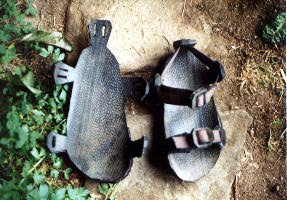
Most importantly, always use tires that do not have steel cables running through them. All tires have some kind of fibrous reinforcement in them, typically nylon or rayon threads. Most of the newer tires also have a layer of steel cables, which is not workable at all. Still, there are a few billion of the older tires around without steel cables, so you should not have to look too far to find some. Just look on the sidewalls of the tire and it will be printed there how many plies of nylon, rayon, or steel are imbedded in the rubber.
We used simple utility knives to cut out our first sandals. Doing it this way you can trace around the pattern on the outside of the tire and start cutting. However, I must say this is very laborious and not much fun. It is hard work, and you could easily slip and cut yourself with the utility knife. Along the way I have discovered that it is much easier and more enjoyable to cut tires using sharp wood chisels or a bandsaw.
To do the chisel or bandsaw method you must first remove a section of tire. This allows you to run the piece through the bandsaw, or to put it on a wooden block, where you can chisel from the inside out.
A circular saw works fairly well for cutting tires, except that it creates a lot of blue-black smoke, and binds frequently. Cut out a piece that is at least a half inch longer than your pattern, and save as much of the sidewalls as you reasonably can. These are useful later for making the buckles. Do not try cutting through the inner edge of the tire, which has an imbedded steel band to fit the tire snug against the rim.
Now, trace the pattern on the inside of the tire, being certain that the pattern is centered and straight on the tire. Even a slight 1/2 inch angle along the length of a sandal can cause problems when you wear it.
I’ve done separate tests, cutting out the sandals with chisels and with a bandsaw, and the bandsaw method is only a little faster. A good set of wood chisels works just fine if you do not have the bandsaw.
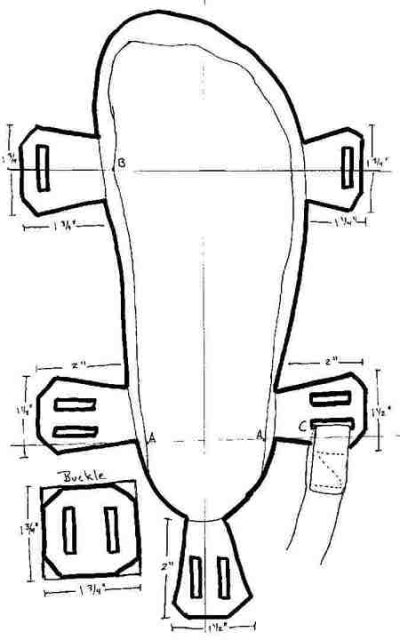
I would suggest making only one sandal at a time, and completing it. Finish the one and try it on; you might think of some modifications to improve the next one. Few of my pairs of sandals are exactly identical, as I usually find some new idea to try on that second sandal.
The next step, after cutting out the sandal, is to thin the four side tabs. The tabs are generally cut from that “corner” on the tire, where there is a thick lump of tread. These are easiest to thin on a bandsaw. You can, however, do a crude but adequate job by cutting the lump down with some careful chiseling or with a sharp knife. Thin down as close as you can to the nylon/rayon plies, without actually cutting any of them. This step is not easy by any method I have found, and I typically leave 1/8 to 1/4 inch of rubber covering the plies, for a total thickness of up to half an inch. That is still quite thick, but thin enough to work.
Now, to make the tabs flex upward, take a razor blade and slice straight into the tread of the tire at the joint where the tab attaches. Slice in all the way until the plies inside are exposed. Be careful not to cut into those fibers.
Chisel out each of the eyelets, where the strapping will be threaded through. For this I use a 1 inch chisel and a 1/4 inch chisel. Be careful to not cut too close to the edge. If you break out the side of a tab, then you generally have to start all over. Also cut a set of buckles from the sidewalls of the tire. These are easy to do.
For strapping, I use a sort of a nylon harness strapping, available at farm and ranch supply stores. 3/4 inch wide strapping works well with the one inch slots. Cut pieces that are extra long, you can trim them off after you thread them through. Use a match, and melt the end of the nylon strap to secure the threads. To do the back strap, thread through the hole marked point (C) on the pattern and stitch an inch or so of the strap back on itself. Thread around through the other eyelets, through the buckle, through the other hole on the first tab, and once again through the buckle. The front strap should be threaded through the buckle, through both eyelets, and back through the buckle again. This system is a little hard to adjust, but once set, I find I can slip my foot in and out, without having to tighten or loosen them.
The finished sandals should be comfortable to wear, although you may need to do some fine-tuning to get them right. For any serious hiking you should wear a couple heavy pairs of socks, or moccasins, or bring along some moleskin.

Learn more at www.hollowtop.com
He is the author of Participating in Nature: Wilderness Survival and Primitive Living Skills and numerous other books on nature and sustainable living.
If you have any comments then please drop us a message on our Outdoor Revival facebook page
If you have a good story, article or blog let us know about it on our FB page, we’re also happy for article or review submissions, we’d love to hear from you.
